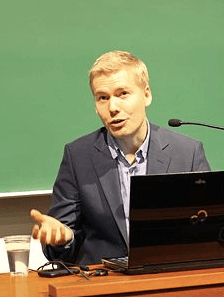The Business of Academia
When Isaac Newton put down his quill and closed the covers of his opus magnum that was Principia, it is difficult to picture the man then sizing which pieces of furniture he’ll have to pawn to afford publishing. And Newton would certainly have been very flustered if a single chapter of his work then cost €50 to read (without receiving a dime of royalties). How many prodigal future scientists would never cultivate their keen minds by sheer lack of coin?
Unfortunately, when it comes to academic research publishing today that scene is not far from the truth. In fact, it’s worse than that. At every step taken towards publishing, editing and ultimately getting access to academic research, scholars are expected to pay – and since scientists’ pockets only run so deep, the bill is passed on to host universities or research funders.
And perhaps this isn’t such a horrible thing, you might think. After all, we tend to think of things in terms of ownership: intellectual property is a good or service like any other. Academic findings, then, are just another kind of product to be owned. But looking aside the somewhat sketchy fact that the content-creators in this story are not seeing any of the profit, I would like to argue that academic research, viz science, is beyond the scope of ownership.
To illustrate this suggestion, take a moment to think about what science really is.
What does science exist for?
To assist you with your moment of reflection, consider the original meaning of the word. Science, from the Latin word scire, that is, ‘to know’, denotes knowledge acquired through systematic intellectual reasoning – and thanks to this we have things like mathematics, the internet and the conquest of Mars just a few years away.
Ok, so science generates knowledge, which is turned into technology, which, in turn, shapes the world around us for the better.
So who owns knowledge? Yes, that’s right, academic journal publishers.
That may sound completely off. But the picture is easier to understand when you think about it as a business. As it turns out, knowledge is worth a lot of money, and academic publishers have that market on a chokehold. In fact, it’s an estimated €22 billion global industry that generates €9 billion in annual revenue at an absolutely dizzying profit margin of 35-40%. In terms of profitability, academic publishing shoves tech giants like Google and Apple into the playground sandbox to play with their single digit margins.
Unfortunately, this perpetual jackpot is also seriously damaging to the progress academics seek to construe through research. And guess who’s paying for the show.
You are.
Triple Pay Tax Play
Let’s make use of another scenario to explain what I mean by that.
A scientist, let’s call him Albert, is interested in physics. Despite being a man of exceptional intelligence Albert still needs to study the hot issues of modern physics in order to know exactly which problems require solutions. To do so, he goes online and collects a scope of pertinent academic papers. However, he notices that he needs to pay about €50 to get access to any single article*. To make matters worse, Albert struggles to tell from the abstracts alone whether that particular research is truly necessary to his intents. Most academic research papers are concerned with very specific topics and a thorough understanding of even a sub-scope of a research field such as physics could mean reading dozens upon dozens of publications. Let’s say Albert needs to read 50 papers. Add a couple of papers that turned out to be useless (say, five), Albert ends his literature review with a checkout bill of roughly €2000.
*Try it yourself. Go to google.scholar and type in whatever field of research you might find interesting. Literally anything. How far can you get without paywalls?
Okay, well, luckily Albert is a student (as researchers often are), which means this invoice is covered by Albert’s host University’s costly journal subscriptions. Still, he’s had to ditch a few important looking papers because his is not a top University and therefore lacks subscriptions to less ‘essential’ journals. Next Albert needs to actually conduct his own research. This means countless of hours of work going into acquiring materials, preparing and conducting experiments, which is followed by the analysis of collected data and finally the write-up of any findings. In terms of used facilities, experiment apparatus and effort, this is a costly endeavour indeed and is likely paid for by Albert’s University or possibly by research funding bodies. In either case, at the backend of these expenses is the government – and of that, your tax money of course.
Once his research paper is finalised, Albert must choose how to publish his findings (or why else go through all that effort?). To improve his career prospects, it is to Albert’s advantage to be published by a well-reputed journal. Intuitively you might think this is due to the exposure this would offer, but that really isn’t the case. But more on that later.

Having chosen a respected publisher, Albert must now pay to be published, typically thousands of euros. Lacking that kind of pocket money, Albert’s University (i.e. you) must pay for this transaction and, finally, Albert’s findings are en route to print. Before that, however, his paper must make it through an army of peer-reviewers, that is, scholars who rigorously screen prospective submissions for any flaws and weaknesses in a process of scientific quality control of sorts. Publishers, who rely almost entirely on the expertise of these academic editors do not pay a dime for this work. Instead, as university-affiliated scholars, they too are on public money payroll.
Thankfully Albert’s work is as ingenious as the man himself, so it passes the screening process and gets approved to be published. In fact, due to being so monumentally innovative, Albert’s paper, along with a few others, make up the first issue of an entirely new journal dedicated to a novel field of research called, eh, superphysics(?). Excited, Albert decides to give a satisfactory glimpse at the fruits of his labor, only to find that his university lacks the subscription for this specific journal. Once informed, the institution corrects this mistake – as they do not wish their physicists to lack access to Albert’s brilliant findings – by promptly purchasing a subscription to the journal, and thus Albert’s work, for an average of €9000 per year. Needless to say, that’s your tax money running down the drain again.
This is pretty much how it works. Each time a wallet was opened in this process, that’s almost surely taxpayer money being used. Private academic publishers are selling our institutions access to research conducted with money paid for by our institutions, at a profit margin of 35-40%.
Michael Eisen, a Molecular Biologist at UCB, could not have said it better – “It’s a ridiculous transaction”.
(Absence of) Public Discussion and Revenue Landscape
To anyone not affiliated with the world of research, the absurdity of what is academic publishing seems to be happening under the radar. And even amongst scholars, it is quite striking how many are not aware of the sheer scope of the problem or simply do not care enough to challenge it – or even talk about it.
‘The general public just assumes that the system is at some kind of equilibrium’, says Mikael Laakso, Associate Professor of Informatics at Hanken School of Economics. ‘They think normal market forces are at play’, he continues.
And it isn’t so surprising. The world of academia often seems like a mystical presence occasionally announcing warnings about climate change or discovered black holes. On the surface, it would appear like researchers are just doing what researchers always do. However, tensions concerning the status quo of publishing have been steadily brewing over the course of the years.
The problem we see today is due to an inadequate adjustment to the changing information landscape – or rather, the accessibility of that information. Before the internet era, publishers produced physical prints of journals; submissions had to be read and edited manually; print production was costly and shipping to client institutions across the world had logistical requirements. This costly production line was covered by subscription fees, and rightly so. However, today’s journals have almost entirely been digitalized, and online accessibility has virtually eliminated the need for costly logistics. In other words, the operational costs of publishing are not what they used to be. Yet the service fees have remained untouched. In fact, they’ve gotten worse, going way beyond adjustment for inflation.

And Libraries and Universities are struggling to keep up with the price of subscriptions. For prestigious journals these are often north of €10 000 per annum, and, for example, top UK universities rack up €4.6 to €7 million a year in subscription fees alone. Expenses of this caliber have played a part in the closure of several academic libraries across the world and as you might guess low-economy countries are the most affected. We’re not far off a dystopian class-based lockdown of information.
Major publishing houses like to argue that operations are running more or less cost-efficiently. However, confirming the veracity of these claims is obscured by secretive non-disclosure agreements between publishers and their clients. In other words, institutions purchasing subscription bundles are legally restricted from disclosing the cost of those deals.
As a result, the makeup of revenue influx of publishing is made unknown. But this practice has negative carry-over effects on the clients as well.
To exemplify the kind of problem this gives rise to, consider the following: you’ve moved into a new place and you need to set a broadband. A major network company makes you an offer, but wanting to be informed, you ask around to see what others are paying for the same service. Alas, you soon find that under contract no one is able to share this information with you.
So you might be getting a good deal; then again you might not – you won’t know. But the service provider, on the other hand, can effectively deduce your capacity to pay, and that gives them a considerable advantage.
Why don’t Institutions opt for Alternative, Cheaper Publishers?
Well, the problem is that due to copyrights, one publisher won’t have the same research to offer as another. Unless you’re ready to change fields of research entirely, you don’t really have other options than to just subscribe to the journal that has the information your researchers need.
And that’s exactly the leverage being used against academic institutions. Libraries and Universities cannot function without a base of academic content their researchers can work with. They need access to publications, and as proprietors of the copyrighted content, publishers can charge as much for access as they please. In fact, you don’t even need to have the rights to particularly ground shaking or essential research to rack good profits. This is because the academic institution will often aim to have access to a diverse scope of research – which means subscribing to as much as is available.
Think back to Newton and the quill he used to write Principia. If there was just a single ink merchant in town, tough luck. He’d pay what they asked.
Or get used to writing on sand.
The Reward Structure and why Transparency Matters
The last serious problem that is rooted in the state of academic publishing comes from the metrics by which academics get merit for their work – and progress their careers. This so-called ‘impact factor’ is a strange term used to describe the supposed significance of a piece of academic work. Yet this could hardly be further from the truth.
The impact factor is an index-over-access metric which calculates the average citations of that journal over the last two years, not of the research itself. The result is that publishing-houses implicitly become valued over and beyond the specific content. When this prestige-based exposure influences the kind of research that gets made, you could say science is officially taking a blow to the knee.
And that is indeed the case. To conduct research, scholars will typically produce research proposals to compete for funding. Amongst other things, the impact factor will play a role in the funders’ selection decision, which means prospective researchers will be inclined to aim to publish in big journals – and state as much in their proposals. Further, Universities get evaluated based on how much of their research gets published in well-respected journals. Taken together, it isn’t far-fetched to see how this might seriously affect what our scholars decide to investigate: if sexy topics have a higher chance on getting published on sexy journals, what do you think a career-oriented researcher will go for? Keep in mind that perfectly publishable papers that don’t fit the ‘sexiness’ criteria could be turned down, which means the researcher will then turn to other publications, and the tax-money funded peer-review process starts again. Wasteful.
One way to avoid this would be to change the current impact factor metrics to multiplier effects – that is, the accelerated impact of results. Multiplier effects take into account views, impact on policy, citations of individual papers – you know, societal impact by and large. Metrics like the multiplier effects are being used by the Bill & Melinda Gates Foundation (bless them) as a basis of funding, but generally, the impact factor is still the norm.
There is, of course, the option of changing the system as a whole.
Academia FREEway
Arguably, Open Access journals are that very change. Conceptually speaking it is an initiative to take some of the publishing cost-burden off by making research freely accessible to the public and as such academic institutions. Thinking back to the argument for knowledge beyond ownership, Open Access is a big lead towards open science that much is clear.
But going beyond the philosophical implications, open access would also allow academic institutions to re-invest funds normally consecrated for subscription fees. Let’s say your average tuition fee for a UK-based 4-year PhD is around €5000 a year: If major universities spend up to €7 million a year on subscription fees, that’s roughly 350 tuition-funded PhD’s, and a great many more research projects suddenly cleared to fit into the annual budget.
Open Access has captured the hearts of a great deal of the academic community, yet its support has not been unanimous. The near-religious following the concept has amassed from its proponents has been criticized for ignoring some substantial issues that this new publishing approach entails. For instance, while the idea of Open Access is fairly simple, its practical implementations are anything but. With no firmly unified effort by the scientific community to adopt open access, a swarm of open access journals has emerged to cater the demands under scarce regulation. And this has turned into one of the main arguments against open access: lack of quality.

‘[the issue is the] rapid growth of new journals for which the peer review processes are basically unknown’, says Laakso, going on to point out the somewhat concerning lack in the ‘kind of verification, validation processes [OA journals] have in place. Realistically, anyone could start a journal and start accepting publication fees in exchange for content exposure’.
And this is what is perhaps scaring some academics and policymakers alike away from open access. However, Laakso explains that, quite on the contrary, open access allows for a transparency which could in actuality lead to better quality research publication.
‘Open access has nothing to do with inferior quality. In fact, many open access journals publish their peer review reports, including critique and open issues, together with the published work.’ You could say Laakso’s views have somewhat of an educated authority: his academic work has been largely focused in the analysis of the Open Access publishing landscape, although in a twist of irony, his work is not exclusively published under such platforms.
‘It’s kind up to the funder where the research aims to be published. But I self-distribute my works quite openly’.
A Whole Bunch of Growing Pains
The other main argument against open access is that it is very expensive at the moment. At least depending on the chosen platform. Since less known journals may be feared due to possibly poor editorial quality, major publishers have capitalized on this known concern by offering special open access publication through their own platforms – at a considerably heavier fee than the regular ‘closed-access’ route. However, with the latter still just a decision away, publishers are now monetizing on both open- as well as closed-access publications, which means increased revenue – and zero incentive to change the way things work.
‘Of course, the price to publish this way is substantially increased. And publishers are well aware that it’s a price they can ask for, as there’s quite a lot of money earmarked for open access publishing by funding bodies such as universities and governments’, says Laakso and continues, ‘And this means the problem is actually getting worse rather than better’.
Now, in addition to retaining most of our research locked behind paywalls, a proportionately large amount of money is being dedicated to small amounts of research on the condition that it is published open access. Add to the mix the impact factor which favours reputed for-profit publishers and you’ve got a real messy situation where open access is being encouraged but is being overcharged by the same players who created the demand for open science, to begin with.
‘So essentially, we’re not flipping the system. We’re just maintaining two parallel systems and it’s very expensive’, Laakso explains.
The True Cost of Open Access Publishing

So what are the real costs of open access academic publishing? The answer to this is not clear cut. In a 2013 financial report, highly reputed biology publisher eLife stated it cost them no less than $14,000 to open access publishing on their platform. Nature put the price at a slightly lesser $10 000 per piece, and Cell has that number at $5000. Most other journals linger in the $1000-$2000 range. Do these costs really add up with expenses? Since publishing comes with hidden costs it’s hard to say. For instance, of the number of academic submissions received, only a select handful make it all the way to print. The rigorous screening process incorporates the costs of copy-editors, outsourced work and file conversions. Rejected pieces are sent back to researchers along with a broad scope critical feedback, and someone has to obviously produce those commentaries, which is time – and money – spent.
Then there’s infrastructural development and cross-industry initiatives that publishers claim to heavily invest in. But even with these budgetary complications pointed out, Laakso can hardly hide his amused disbelief.
‘I mean there are several numbers floating about, but what’s more or less certain is that the actual cost of publishing, or to maintain a publishing platform, ranges between $100-$200 per academic paper.’
And there are other costs that publishers may feel inclined to not speak about. These would include lobbying efforts, PR departments and copyright lawsuits. The latter, while not done very openly, is nevertheless put into action every now so often. For instance, Princeton University researchers have been given takedown notices by academic publisher Elsevier for sharing copyrighted research a little too openly in the past. While the school sided with its researchers, leading to a quiet dropping of legal actions, it goes to show that publishers certainly set aside funds for legal enforcement of copyright.
And while one might still be inclined to feel that publishers indeed have their cost-efficiency at a balanced state and the betterment of academia at their hearts, scholars headhunted to work in the publishing sector tend to state that the job was basically managing the journals to increase profit margins. If there are noble intentions behind all of this, it is really hard to see them.

And then there is Aaron Swartz. Aaron is perhaps best known for his involvement in the founding of Reddit but he was also a prodigal coder and startup entrepreneur turned political philanthropist. His efforts played a big part in why the 2012 Stop Online Piracy Act (SOPA) never passed in the US. On paper, the controversial bill was intended to fight online copyright infringement but in practice would have placed impossible supervisory expectations on online service providers by basically threatening website closure for any kind of content violating copyrights without due process. What is less known is that in 2011, a year before his campaign against SOPA, Swartz’s laptop was found in the MIT server room using customized code to mass-download normally paywalled academic research articles through the university’s credentials. Swartz, in a blog-post years prior to these events, had expressed his penchant for open access science, which catalyzed a politically motivated legal crusade against him by the US government. Unwilling to accept a plea deal, Swartz decided to fight back the 14 felony charges brought against him – and face up to 35 years in prison. Soon after, he was found dead by hanging in his apartment. A suicide, it was said.
Swartz’s tragic fate is hardly a direct result of what academic publishing has become, yet it came with a clear message: academic research is not free for grabs; those who treat it so are to be considered dangerous criminals. But again I wish to remind you that the research in question is publicly funded. And is it truly so crazy to think that academic works such as those by Newton or Chomsky should be free to us all?
That’s for you to decide.
The change swipes through Europe
There’s one last thing I feel like I need to talk about, and that’s the future which academic publishing is going to face. And looking at Europe, it would appear that Open Access is the way (whether we like or not).
Plan-S is the European initiative to make future research freely accessible through open access publishing by the year 2020. It’s a policy backed by the European Research Council as well as a coalition of national research funders in Austria, France, Ireland, Italy, Luxembourg, the Netherlands, Norway, Poland, Slovenia, Sweden and the UK, so big players all around. However, Plan-S has been met with much controversy. Its 2020 deadline is ambitious and research prior to that date is beyond its influence. Concerns have been expressed over the potential negative impact the plan will have on academic freedom by coercing the community to change their publishing behavior through legislative force. What’s more, the policy steams on at full force while not having been fully fleshed out. It could be argued that a few years is simply not enough for a system change that upholds the systematic and critical integrity of science.
Laakso says Plan-S is mostly a pressuring device intended to put publishers on their feet. There is clearly a demand for change, but publishers can still be a part of that change. Their expertise and infrastructure could have a lot to offer, but this means less money-hungry attitudes and more openness for discussion. ‘Its an ongoing negotiation’, says Laakso.
But like in politics, negotiations between the parties are not always done in the best of terms. The level of publicity at which this mediation is taking place, i.e. policy announcements, indicates exactly how awkward the back and forth is at the moment. ‘It’s really clumsy dialogue. It would be much better if policymakers and the publishing sector actually sat down around a negotiation table and had a direct discussion’, Laakso says.
Ok, you’ve made it this far, and perhaps you’re now wondering if there’s any conclusion in sight so you can finally get on with your life. Unfortunately, there is scarce closure I can offer which hasn’t been merely implied. Open Access is the way of the future, that much I would argue to be clear. Yet while it has made tremendous progress since its inception, the progress of Open Access is slowing down and we are far from having achieved the level of transparency or taxpayer cost-efficiency that academic research deserves. But this means it is very much an open playing field. One of the few major technological innovators here is Google and while a daunting presence as the only serious competition around it means Open Access development has plenty of room for fresh innovation. And entrepreneurs should want open access because it creates a completely new market for a desperate need for improved solutions. So far, what we are seeing with policies such as Plan-S are transitional models that have given us a scope of change for the next five to ten years. These aim to get rid of costly subscriptions. But publishing is still overtly costly and editorial processes could likely be made more dynamic. Or, for example, visibility through multiplier effects are an important potential idea to incorporate as a front-end feature. Plenty to work with, indeed.
And what about after the transition? Academic publishing needs an infrastructure that comes from a backend of governments, consortia, and institutional co-operation. Who is going to build it?
‘Getting to the open source stage would free up quite a lot of money, which could be used to develop more sustainable models that would eliminate the need of author-side fees’, Laakso says. His vision, one shared by a considerable body of scientists, would see academic research becoming a truly shared and public endeavor, from conducting the research itself to publishing and accessing the findings.
Some of the tools to make this happen are already available – and free. The Open Journals System, crossref metadata which contain article indexes along with APIs are all open source and ready to use. But while it will be tempting to see this is as nothing else than an opportunity to capitalize, it is of the essence to keep in mind what all of this will be used for, and the damage already caused by a preference for easy income.
Cancer, climate change, depression, none of us are truly safe from their destructive influence. Our only weapon against them is and always has been the knowledge of how to fight back. Academic research, in response, has given us chemotherapy, clean energy, and psychology. But of course our knowledge is incomplete, and better solutions are yet to be found. And it is to all of our interest to make that process of discovery easier, and giving away what we’ve already found to be locked behind paywalls is not that.
Let’s tear down the tollgates.
PS: For anyone interested in getting further first-hand accounts on many of the issues discussed in the article, I would highly recommend watching Paywall: the Movie (It’s free).
PSS: While presenting views from just one side creates a skewed overall picture, I would like to underline that our attempts to reach out to several academic publishers were not answered. If you, the reader, disagree with any of the views presented in the article, feel free to express these in the comments section.






